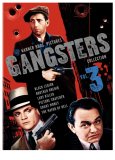| Reviews & Columns |
|
Reviews DVD TV on DVD Blu-ray 4K UHD International DVDs In Theaters Reviews by Studio Video Games Features Collector Series DVDs Easter Egg Database Interviews DVD Talk Radio Feature Articles Columns Anime Talk DVD Savant Horror DVDs The M.O.D. Squad Art House HD Talk Silent DVD
|
DVD Talk Forum |
|
|
| Resources |
|
DVD Price Search Customer Service #'s RCE Info Links |
|
Columns
|
|
|
Warner Bros. Gangsters Coll.: Vol. 3 - Smart Money, Picture Snatcher, Mayor of Hell, Lady Killer, Black Legion, Brother Orchid
Coming in with a sensational third volume of slam-bang, funny action mellers, Warner Bros. Pictures Gangsters Collection: Vol. 3 features the classic triumvirate of American gangster icons - James Cagney, Edward G. Robinson, and Humphrey Bogart - leaning heavily towards some snappy Cagney flicks (four features, three top-billed), with Robinson (two starring turns) and Bogart (one starring turn in an almost gangster film, and a nice assist with Robinson), rounding out the offerings. 1931's Smart Money, Picture Snatcher, The Mayor of Hell, and Lady Killer (all three from 1933!), 1937's Black Legion, and 1940's Brother Orchid are the line-up (contained on individual discs with hardshell cases), and all of them are presented here with terrific transfers and thoughtful, copious (for these types of "library titles) extras, making Warner Bros. Pictures Gangsters Collection: Vol. 3 a must-have title for lovers of that greatest period of the Hollywood dream factory. Let's look at the individual films.
SMART MONEY
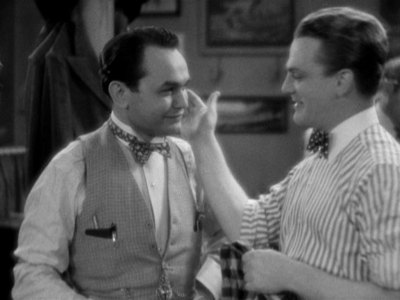
Small-town barber Nick Venizelos (Edward G. Robinson) has a nice little racket going in his popular Irontown barbershop. Haircuts are plentiful, but all kinds of gambling action can be found behind the parlor after hours. Encouraged by his friends and cronies, including fellow barber Jack (James Cagney), to try his seemingly unstoppable lucky streak in the "Big City," Nick puts up his shop (along with stakes from his friends) and cobbles together 10 large, ready to take on notorious gambler Hickory Short.
Once in "The City," Nick tracks down the hotel of Hickory's traveling game, and with the help of gorgeous candy counter dame Marie (Noel Francis), he locates Hickory's room number, and confidently enters the game. Nick only has one problem, though: "Hickory" is really Sleepy Sam (Ralf Harolde), whose gang has rigged the game - with the help of Marie who sends suckers up who think they're gambling with Hickory. Quickly relieved of his wad of notes, Nick leaves dejected, and eventually finds out he's been swindled. Vowing revenge on Marie and Sleepy, Nick is forced to go back to working as a barber (along with Jack, who has come up to the city to help Nick) until his returned gambling prowess (here, picking winners in horse races) impresses wealthy Greek customer Alexander Amenoppopulus (Paul Porcasi) enough to stake him at another attempt on Sleepy Sam.
Tracking down Sleepy Sam in another city, Nick turns the tables on the little chiseler and his gang, as well as taking the real Hickory Short for another 300,000 on a train bound for "The City" (not shown on screen, but detailed in a newspaper insert shot), which gives Nick the necessary dough to be the new big cheese for gamblers in "The City." But as every true gambler knows, luck comes in waves of good and bad, and Nick's time on top is short-lived.
SPOILERS ALERT!
Starting the Warner Bros. Pictures Gangsters Collection: Vol. 3 in order of their release dates, thereby watching 1931's Smart Money first, I was immediately taken again with the blistering, raucous, licentious, "anything goes" energy of the pre-Production Code films of Hollywood, particularly the rowdy, fast-paced little numbers that the Warner Bros. specialized in for their equally impatient, boisterous urban audiences (where Warners owned many of their own theatres). Many critics have commented on that "golden" period of freedom that briefly flourished in the mid-to-late 20s up to 1934, when the infamous 1930 Production Code was finally enforced. The usual mantra is that the American cinema was somehow "stunted" artistically for decades from this enforcement (a serious misreading of apples and oranges), but it's not hard to see how appealing (in a different, vital, thoroughly "modern" way) this period looks to today's viewers and critics when seen in comparison to the later "tamed," post-'34 offerings (a good example being Brother Orchid, included in this set). Smart Money, like the other films included in the Warner Bros. Pictures Gangsters Collection: Vol. 3 set, move. Conceived and produced under the Depression-era economics that the studios needed to enforce to survive, these little programmers are fast, funny, violent, and beautifully lean and spare in their economical storytelling techniques. Directing and editing choices are fitted together like clockwork pieces, achieving a completeness of experience that you simply don't get with today's bloated, unfocused, frankly amateurish "big budget" spectaculars, lame-brained "adult comedies," and horribly underwritten, narrow dramas. It's no exaggeration: these seemingly "geriatric groaners" ("You mean...they're in...black and white!!!") from over seventy years ago, explode off the screen with a sureness and confidence you simply can not get from today's cinema.
Smart Money may disappoint fans of gangster films who are looking for this famed, one-time-only pairing of two giants of the genre, Robinson and Cagney, particularly when one sees how little Cagney is actually given to do here. Not yet the marquee equal of superstar Robinson, Cagney was filming his breakthrough The Public Enemy at the same time as Smart Money (a common Warner Bros. money-saving method), so he's relegated to the sidelines here, whenever he does manage to get on screen. He does have an amazing little bit where he mimes to Robinson the info that a dame is waiting outside the door, but it's clear from Cagney's face - and somewhat subdued energy level - that he's merely clocking time here.
Fans of the great Robinson, though, will be intrigued by Smart Money's twist on the "Little Caesar" persona that made Robinson a world-wide icon. Melding the "small town hick taken in the Big City" opening of the film, along with the more familiar (for the "Rico" character) "hood climbs to the top - only to fall by tragic means" framework, Smart Money keeps the tough-guy slang coming at a furious clip (I love Robinson commenting on his various women: "Nothing but favorites in my stable."), but also allows Robinson to stretch a little bit, making his Nick the Barber character a genuine hero of sorts, continually "rescuing" women in distress (particularly if they're blonde, his obsession), while achieving a level of pathos when he falls, accidentally killing his friend Jack over a simple misunderstanding, right when Nick apparently has it all. Risque themes of sex, implied violence and exploitation are here for anyone to see (just what does that first girl whisper to Robinson, when she bums a C-note off him? Does she need an abortion? Does she need to pay off her pimp, Boris Karloff?). It's a resolutely hard, male world presented in Smart Money; modern audiences will no doubt balk at the casual racism of the ethnic humor on display; Robinson frequently implores his black friend Snake Eyes (John Larkin), to bend over so he can rub his head for luck (mitigated somewhat by the fact that Snake Eyes is treated more or less as an equal to Nick, and as a loyal friend). And the mistreatment of women (or at least, some women deemed "fallen") won't play for the rigidly dogmatic (the plant sent by the D.A. to trip up Nick gets a swift kick in the rear), but as always with these films from this period in history, context is everything.
It's hard to discern if the ending of Smart Money is ironic or simply "Hollywood" in its seemingly happy ending. Nick seems confident he'll be back from prison, while his friends bid him farewell at the "Big House" train. Is it his usual false bravado, spurring on his own self-confidence and those around him, despite the utter ruin that faces him, or is it simple Warner Bros. way of sending everybody in the theatre seats home with smiles on their faces? Finally, that's what wonderful about these marvelous little programmers; ultimately; the answer doesn't have to be one or the other.
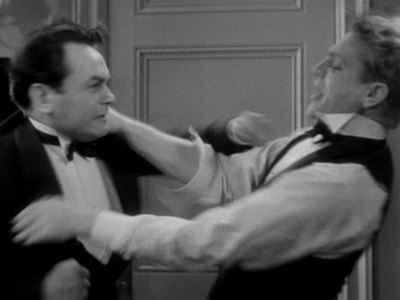
The DVD:
The Video:
The full screen, 1.33:1 black and white video transfer for Smart Money does have the requisite grain and scratches and blemishes one would expect from a seventy-plus-year-old film, but the picture does have a nicely balanced gray scale, even though the picture is soft at times (due no doubt to the original lensing). It certainly looks better than I remember it on VHS or definitely TV, so enthusiasts of vintage films won't be disappointed here.
The Audio:
The Dolby Digital English mono audio track accurately recreates the original theatrical presentation. English and French subtitles are available, as well.
The Extras:
All of the titles in the Warner Bros. Pictures Gangsters Collection: Vol. 3 have a full-length commentary track - a nice option for these lesser known "library titles." Here, film historians Alain Silver and James Ursini discuss the film in a somewhat pedantic fashion (if there's one overused cliche of tony "film criticism" that should be given a rest, it's the dreaded "homoerotic" angle that's trotted out any time a film features two male leads - particularly when that theory has nothing to do with this film), but they do provide plenty of insider info for the fans.
There's also an option on all of the Warner Bros. Pictures Gangsters Collection: Vol. 3 films to watch the main flick with the Warner Night at the Movies feature, with a "Play All" ability to view some vintage trailers, newsreels, short subjects and a cartoon before the main feature unspools - just as moviegoers experienced these films back in the 1930s. It's a fun concept (didn't Warner try this on VHS years ago?) that works even better on DVD, because you can also cherry-pick which extras you may want to watch alone. For Smart Money, an original trailer for William Wellman's 1931 opus, Other Men's Women is included. There's a short newsreel clip showing Al Capone getting sent up to the Big House for eleven years (it runs 22 seconds). There's a Vitaphone Varieties short subject, running 8 minutes, featuring George Jessel and His Russian Art Choir, along with an amusing short subject featuring funny Walter O'Keefe and Margaret Lee in The Smart Set-Up. It runs 18:32. And rounding out this night at the movies, there's a 1930 Looney Tunes Hugh Harman/Rudolf Ising musical cartoon, Big Man from the North, produced by Leon Schlesinger. It runs 7:46.
PICTURE SNATCHER
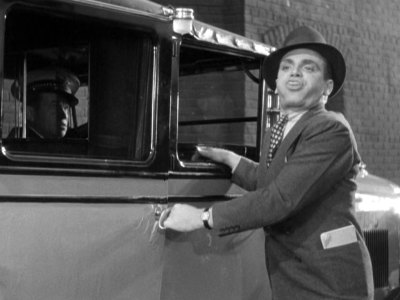
Ex-con Danny Kean (James Cagney), fresh out of notorious Sing Sing prison, returns to the Big Apple with some startling news for his gang: he's giving up crime to become a cub reporter on the Graphic News, a fourth-rate scandal sheet that makes its nickel sales by publishing salacious photos of sensational crimes. Jerry the Mug (Ralf Harolde), Danny's top gunsel, isn't too pleased, but nobody says no to Danny, and Danny's soon off to the Graphic News, intent on getting a job.
Meeting Al McLean (Ralph Bellamy), the alcoholic reporter who initially offered a job to Danny while still in the stir, Danny isn't bowled over by the dejected, soon-to-be fired McLean - and vice versa for McLean, who rejects Danny's request outright. But when McLean learns he's out unless he scores big with a new assignment - getting a picture of an armed, unbalanced fireman who's holed up in an apartment - he turns to Danny who assures him he can get the shot. And that's just what he does, conning the pathetic fireman and not thinking twice about betraying the poor man's trust in Danny's phony cover story (he claims to be an insurance agent out to help the fireman). Danny is the new wonder boy on the Graphic - thanks to additional help by man-chasing co-worker Allison (Alice White) who happens to be Mac's girl - and soon his reputation for scamming his way through every situation makes him the one to watch at the paper.
Trouble doubles for Danny's romantic life when he becomes involved with journalism student Patricia Nolan (Patricia Ellis), a sweet tomato who just also happens to be the daughter of Lieutenant Casey Nolan (Robert Emmett O'Connor), the very same cop who put a bunch of slugs into Danny's back and sent him up the river to Sing Sing. Naturally, Nolan is apoplectic at the thought of Danny and Pat getting together, but Danny's offer of free newspaper publicity is too good to pass up, so everything's jake with his dating Pat - until Danny's typically loose interpretation of "gratitude" gets in the way. Offered the chance to snap a priceless (and illegal) picture of a female prisoner getting fried on the hot seat, Danny abuses his newfound friendship with Casey to secure the shot, resulting in a wild chase by the cops - and Casey's eventual demotion. And if that's not all, Danny's former gangster friend, Jerry the Mug, goes on a rampage, killing two cops. It's up to Danny to bring him out of his second-story armored lair, while clearing things for Casey, and squaring things with Pat.
SPOILERS ALERT!
Whew! Shot and edited at an electrifying 77 minutes, Picture Snatcher is the quintessential early 30s Cagney programmer. Written by Allen Rivkin, P.J. Wolfson, dialogue by Ben Markson, and directed by that largely unsung studio craftsman, Lloyd Bacon, Picture Snatcher is a breathless, breezy comedy/gangster/newspaper thriller genre concoction that showcases Cagney at his earliest, gutsiest best. This is the Cagney that audiences in New York lined up literally around the clock at theaters running his films 24 hours a day (can you imagine any two-bit "star" from today earning such fevered adoration?). Every mannerism that made up the star's iconography is delightfully highlighted. Boundlessly energetic, infinitely, arrogantly confident, cynical, violent, balancing on the balls of his feet as his hands execute numerous Bronx-cheer accompaniments (his raucous raspberry to the competing newspaper hounds on his first assignment, is a moment to absolutely treasure), Cagney's sneering, vulgar, street-wise delivery was a sensational revelation to audiences accustomed to the smoother, cultured, genteel heroes over at the other Hollywood studios. He is the absolute pinnacle of the anti-authoritarian, nose-thumbing, laughing-in-your-face, go-getting American who remains positive - a character and vital role model in American movies that has been forever eliminated by the fatally ironic, deathly morose navel-gazers that have populated movie screens for the last forty-odd years now. Watching Cagney here is to know an actor literally bursting at the seams to perform, to entertain the audience, and his connection with the viewer is electric.
It helps that his vehicle here, Picture Snatcher, is so crudely in tune with his persona. Looking to slightly tweak the rough-and-tumble gangster character Cagney had so successfully essayed before, so as to fit the more romantic, slightly more comedic vehicle here, Cagney adds plenty of his celebrated "goodies" (his term for lighter moments - sometimes improvised - that would endear even his amoral psychopaths with the audience) to garner acceptance for that cocky little bastard Danny. Listen to all the times that Cagney bursts out into this almost insane, raucous laugh whenever something strikes him funny; you don't hear a laugh like that from even the likes of Jim Carrey! It's an amazingly transcendent moment (particularly in the context of other 1930s films). The film itself moves effortlessly (thanks to Warners' lightning-fast, and penny-pinching, editing schemes) from comedy to action to drama to romance moments, giving the punters plenty of what they want: to see their own obstreperous lives romanticized up on the screen by their favorite proletarian star.
I love the seedy newspaper milieu that Picture Snatcher conjures up, with reporters and editors moving freely up and down the morality scale depending on the failure or success of a particular scoop. These scenes provide most of the comedy (I love it when Danny, who's noted for stinking at actually taking pictures, finally gets it right, and the photo editor screams, "He's got it! He's got it! And it's a good one!"), with Cagney giving one of his signature rat-a-tat-tat dialogue scenes where he rapid-fire describes his covert electric chair shoot (see his beautiful, screamingly funny performance almost thirty years later in Billy Wilder's One, Two, Three, where he does this non-stop for two hours). The romance scenes with Pat - while avoiding the wrath of Pat's father, Casey - also get a lot of comedic mileage, culminating with Casey taking shots again at a fleeing Danny (which the screenwriters top by having Danny laughingly celebrate his escape with his exact animal counterpart: an alley cat). Picture Snatcher is full of clever, funny little moments like that, but it doesn't forget its gangster underpinnings, ending with a nicely staged shootout (somewhat reminiscent of Hawks' Scarface) that no doubt pleased the action fans in the audience, but which didn't forget to add another perversely amusing twist, with Danny getting a quick photo of Jerry the Mug right at the moment of his getting ventilated. It's a wowser climax for this cynical laugh-getter, clearing the way for the film's romantic entanglements to be sorted out, Cagney-style (Cagney gives the amoral Allison a quick rap to the mug when she once again forces herself on him).
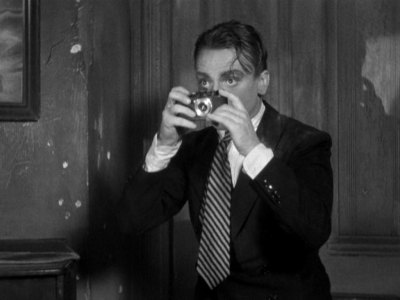
The DVD:
The Video:
The full-screen, 1.33:1 black and white video transfer for Picture Snatcher does have the expected grain and some minor screen imperfections that one might expect from such a film, but overall, it's quite a nice presentation here, with a bright, clear picture, and a nicely modulated gray scale. Taking into account the short running times of all these films, it's not surprising that compression issues are non-existent.
The Audio:
The Dolby Digital English mono audio track accurately recreates the original theatrical presentation. English and French subtitles are available, as well.
The Extras:
All of the titles in the Warner Bros. Pictures Gangsters Collection: Vol. 3 have a full-length commentary track - a nice option for these lesser known "library titles." Here, film historians Jeffrey Vance and Tony Maietta discuss the film, and they're a marked improvement over the first group of commentators. These guys are enjoying watching and discussing this film, and that obvious delight is infectious with the viewer (a rare thing with these usually boring commentaries). And when they don't know a particular bit player's name, they admit it - and then laugh about it. That's a classic. Tons of fascinating tidbits are thrown out for the trivia-obsessed; I'd really like to see these guys team up again for more commentaries.
There's also an option on all of the Warner Bros. Pictures Gangsters Collection: Vol. 3 films to watch the main flick with the Warner Night at the Movies feature, with a "Play All" ability to view some vintage trailers, newsreels, short subjects and a cartoon before the main feature unspools - just as moviegoers experienced these films back in the 1930s. It's a fun concept (didn't Warner try this on VHS years ago?) that works even better on DVD, because you can also cherry-pick which extras you may want to watch alone. For Picture Snatcher, there's an original trailer for the main feature, as well as one for D. Ross Lederman's 1942 Escape from Crime, and a trailer for Robinson's 1933 effort for director Alfred E. Green's I Loved a Woman. There's a vintage newsreel showing Machine Gun Kelly getting nabbed (it runs 53 seconds). There's a musical short subject, Plane Crazy, starring Dorothy Lee and directed by Roy Mack (with some snappy Busby Berkeley-like musical numbers), which runs 19:33. And finally, there's a Merrie Melodies cartoon, produced by Hugh Harman, Rudolf Ising and Leon Schlesinger, Wake Up the Gypsy in Me, that runs 7:24 (note: during the end credits, it is indicated this is a "dubbed version for Turner Networks - cartoon experts will have to see what has been altered).
THE MAYOR OF HELL
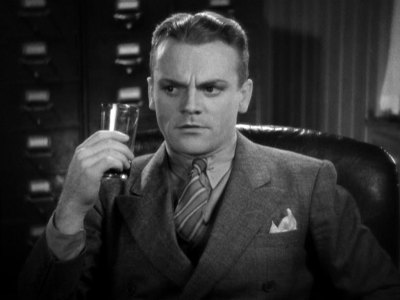
Far more somber than the Cagney films that proceed and follow it, The Mayor of Hell is a gritty, hard-boiled look at reform school terrors, obviously modeled after the previous year's smash hit, I Am a Fugitive from a Chain Gang. Directed by another lamentably unsung hero of the studio system, Archie Mayo (with the film's finale contributed by action specialist Michael Curtiz), The Mayor of Hell opens with the story of punk kid Jimmy Smith (Frankie Darro). Convicted with his gang of brutally assaulting a candy store owner, Jimmy is sent off to the dreaded State Reform School, a thinly-disguised prison camp overseen by a vicious, psychotic superintendent, Mr. Thompson (Dudley Digges). The angelic presence of Nurse Dorothy Griffith (Madge Evans) does little to counter the deplorable conditions at the "school," including inedible food, strenuously long working hours, and crushing discipline ordered by Mr. Thompson.
Obviously, the obstinate Jimmy is going to clash with Mr. Thompson, but their battle of wills is interrupted by the arrival of Patsy Gargan (James Cagney), a cocky ward heeler who's being rewarded for bringing 5,000 votes to the big city's political machine by getting the cushy job of deputy commissioner for the reform school. Not intending to do anything but show up once a year to collect a year's worth of salary, Patsy is genuinely affected by Thompson's treatment of Jimmy, who tries to escape the night he arrives, and who receives a taste of the lash from the psychotic Thompson. Gargan warns off Thompson, but he doesn't formulate a specific plan until he speaks with the lovely Nurse Griffith, who eventually sells the on-the-make Gargan on the idea of the boys having self-government to better their lives at the school. When Gargan fails to get control of the school from Judge Gilbert (Arthur Byron), he goes to his ward boss, Louis Johnson (Edwin Maxwell), who promises to go right to the top (the governor) to pull some strings. Gargan is awarded control over the boys, and Thompson is set off for an enforced one-month vacation.
Getting decent food into the young boys immediately lifts their spirits, and Patsy and Madge's experiments in self-government (including no more double-time, no more whistles, no more guards, and a library) seem to be working, but a call from his gang lets Patsy know that Joe (Harold Huber) has frozen Patsy out, a situation Patsy reconciles by leaving the school and shooting Joe, almost to death. On the lam, Patsy has to hide out, away from the school, which Thompson finds out about from an insider. Crushing all of Patsy's reforms, Thompson goes on a rampage, returning the school to even worse conditions than before Patsy's arrival, which sets the boys on the verge of rioting.
SPOILERS ALERT!
There are quite a number of elements to enjoy in The Mayor of Hell, chief among them the usual speed and efficiency of the storytelling, courtesy of Warner contract director, Archie Mayo. A supreme craftsmen of economical storytelling, Mayo keeps the main story line crackling along, while maintaining superb performances from the cast, particularly from stage great Dudley Digges, who is memorable as the horrific, Dickensesque villain Thompson. The early section of the film, which details the misdeeds of the boys, may not play as sympathetically today as it may have in the 30s (a thief is a thief is a thief, to paraphrase), but certainly the social concerns of the film and of the studio are in the right place, as the film demands that reform schools should indeed reform, and not just punish, their young charges. The film is surprisingly fair in treating the justice system as necessarily even-handed, but anyone looking below the surface will recognize the criticism of the cronism that produced a Thompson in the first place (and which seems content to ignore him as he plays his sadistic little power games while skimming the public dollars meant for the boys), as well as the political machines that reward a vote-getter gangster like Patsy with a public servant job.
Certainly Patsy's sudden conversion to avenger for the boys is The Mayor of Hell's weakest link. Whether it was due to the rapid-fire exposition that was de rigeur with these Warner Bros. potboilers, or just underdeveloped scripting, it's never entirely understandable (or believable) as to exactly why Patsy does cross over from self-serving gangster to Father Flannagan. Of course, Cagney is full of beans and nicely modulated in his subtle menacing of Thompson when he takes over; he's got the gangster part down pat. But I don't believe him with the boys here like I do in his later "gangster-takes-boys-under-his-wings" classic, Angels with Dirty Faces. For that matter, the boys' continual shock at the reform school's injustices doesn't play, either; little hoods like these would undoubtedly have known older boys from the same neighborhood who did time there, and their stories of outrage would no doubt have been transmitted back to the future inmates. Perhaps Cagney knew his character's actions weren't sufficiently explained or motivated here; it's hard to say. But without believing a hard cookie like Patsy would immediately melt for punks he grew up with his whole life, The Mayor of Hell becomes a much tougher sell as believable melodrama -- a dilemma that's made even more difficult when the necessities of the script require Cagney to essentially disappear during the crucial final third act, until his last-minute Hail Mary return.
Fortunately, with the speed and expertise of the Warner studio system, you don't have to necessarily believe a thing in The Mayor of Hell to enjoy it, because everything is geared so mechanically and professionally towards getting across the story in as efficient and effective method as possible. The cleanliness of Mayo's schematic is such that each sequence blends effortlessly with the next, producing a seamless little actioner that doesn't need to rely on its iffy social utopian ideals (hey, let's give the little nippers books and chocolate bars, and they'll be right as rain), or even a lead character who's not exactly clearly motivated. It's fast, entertaining, and it moves, and that's enough here. For unknown reasons (according to the commentators on this disc), action director Curtiz was brought in for the rabble-rousing finale, which looks suspiciously like the denouement of Universal's Frankenstein, but it's still undeniably exciting, particularly when Thompson receives his gruesome ending: an appropriate, gory fall on a barbed wire (that one was for Jimmy), before landing dead among the rutting pigs in their stye. Evidently, the film's original finale was designed quite differently, with Thompson committing suicide, but this ending is a much more satisfying fit for the screenplay's arc.
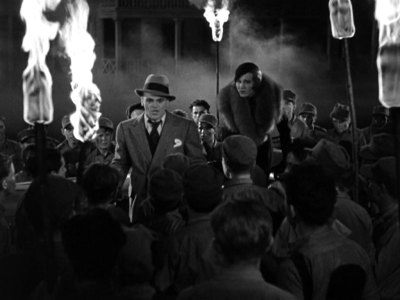
The DVD:
The Video:
The full-screen, 1.33:1 black and white video transfer for The Mayor of Hell looks remarkably clean and vibrant, with a perfectly balanced gray scale and little or no grain (in comparison to the two previous pictures). No compression issues at all (a real bonus considering Warners went with the more expensive option of putting each of these short films on their own discs).
The Audio:
The Dolby Digital English mono audio track accurately recreates the original theatrical presentation (at times, it's a little squelchy here, but overall, more than adequate). English and French subtitles are available, as well.
The Extras:
All of the titles in the Warner Bros. Pictures Gangsters Collection: Vol. 3 have a full-length commentary track - a nice option for these lesser known "library titles." Here, film historian Greg Mank discusses the film, and he's terrific. He has an encyclopedic recall of the numerous cuts that censors made to the controversial film (fun facts that rarely get discussed on these kinds of commentaries), along with copious other production details (including detailing how the finale was re-structured), making for an enthusiastic, fact-crammed commentary. I'm looking forward to more commentaries from Mr. Mank.
There's also an option on all of the Warner Bros. Pictures Gangsters Collection: Vol. 3 films to watch the main flick with the Warner Night at the Movies feature, with a "Play All" ability to view some vintage trailers, newsreels, short subjects and a cartoon before the main feature unspools - just as moviegoers experienced these films back in the 1930s. It's a fun concept (didn't Warner try this on VHS years ago?) that works even better on DVD, because you can also cherry-pick which extras you may want to watch alone. For The Mayor of Hell, an original trailer for The Mayor of Hell is included, along with its two remakes: 1938's Crime School and 1939's Hell's Kitchen (a nice inclusive touch here from Warners). As well, there's an original trailer for director Michael Curtiz' sensational Philo Vance mystery, The Kennel Murder Case. There's a newsreel detailing Attorney General Cummings efforts in the Department of Justice to reign in the marauding racketeers; it runs 1:18. The Audition, a Vitaphone musical short subject directed by Roy Mack and featuring Hannah Williams, Three X Sisters, Larry & Larry, and Phil Emerton's Band runs 9:16. And finally, a Merrie Melodies cartoon, produced by Leon Schlesinger, Hugh Harmon and Rudolf Ising, The Organ Grinder, is included, running 7:13 (note: during the end credits, it is indicated this is a "dubbed version for Turner Networks" - cartoon experts will have to see what has been altered).
LADY KILLER
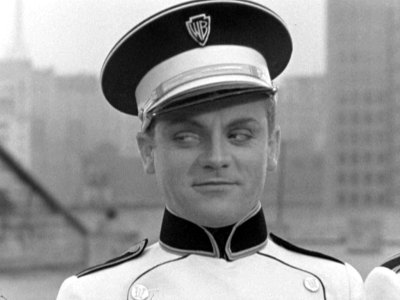
One of my favorite Cagney films, Lady Killer, is an insanely-paced comedy/gangster/Hollywood insider spoof that plays as fresh today as it did over seventy years ago. Almost surreal in its rapid-fire ellipses between genre conventions, Lady Killer is the fastest-paced, most entertaining film I've seen this year (what a sorry comment on the current state of affairs in Hollywood, right?). Cagney plays Dan Quigley, a smart-assed, jumped-up movie usher who quickly gets the sack for gambling, chewing gum, and smarting off to the customers. Making time with one of his dames at a hotel, Dan spots gorgeous Myra Gale (Mae Clarke) dropping her purse, and tracks her down back at her apartment. Hoping to make time with her, he discovers she must be married, because in the drawing room, her "brother-in-law" Spade Maddock (Douglass Dumbrille), who has a nice little poker game going, introduces himself. Dan, never one to pass up a chance to gamble, invites himself in, and promptly gets taken. Laughing it off, he leaves the apartment, only to discover it's all a scam (another punter comes up with one of Myra's many "lost purses"). Immediately challenging Maddock's authority, Dan doesn't blow the whistle on them; instead, he muscles in on the action, demanding 10% of all future takes in the scam. Within a month, the gang, now headed up by Dan, has acquired the fancy "Seven Eleven Club," a swanky gambling joint in the heart of the city.
But Maddock isn't satisfied with just gambling proceeds; he wants the gang to branch out into high-class burglaries, which Dan goes along with - until someone gets killed on a job and everybody has to lam out of New York. Arriving first in Chicago, Dan and Myra decide to go to Los Angeles, where the cops are already onto Dan. He's locked up, but Myra skips out of town with Maddock (who also hit L.A.) and his bail money, so vagrant Cagney picks up a job as a movie extra, eventually working his way up to promising feature player. Equally promising is his relationship with beautiful star Lois Underwood (Margaret Lindsay). However, the sudden arrival of Myra and Maddock threatens to destroy Dan's career and reputation, and tough-guy gangster Dan has to ditch his smooth on-screen persona to defeat the criminals.
SPOILERS ALERT!
If you watch the films of the Warner Bros. Pictures Gangsters Collection: Vol. 3 in release order, it's apparent that Cagney has finally come into his own here in Lady Killer. It's such a smoothly comedic/dramatic performance, clearly showing the rising assuredness of his craft, that you wonder what he has left to show audiences. There are so many quintessential "Cagney moments" here - Cagney defiantly sticking out his chin while chewing gum, laughing hysterically at a drunk movie customer who tickles his funny bone, topping his grapefruit-smashing scene with the thoroughly no-good Clark from The Public Enemy here by dragging her around the apartment by her hair and kicking her in the ass for good measure - that anyone trying to understand the enormous appeal of this actor need only check out this one film to see his native appeal, crystallized in all its early 30s glory.
The film itself is wonderfully scatterbrained, playing often like a screwball comedy even though serious elements of gangsterism follow through the story arc. Taking the all-time most popular film magazine fantasy of early moviegoers (any mug - even that usher showing you to your seat - can become a movie star), and mixing it with elements of Cagney's own meteoric rise to fame in Hollywood, Lady Killer is careful to keep Cagney entirely removed from the moments of violence that could potentially alienate the audience (the robbery of the rich lady's mansion, where a maid is killed, isn't shown, and we're not told if Cagney even took part in the actual robbery) and bring down the mood of the piece. Certainly the lightest moments of the picture occur in the central sequences spoofing Hollywood, and they're charming (I love Cagney, dressed as an Indian Chief, complaining in Yiddish that "Big Chief es tut mir veh im tuchas" after spending all day on a mechanical horse!). A delightfully surreal moment comes when the lovely Margaret Lindsay celebrates her birthday, and Cagney brings her her gift: a craft of two dozen crazed monkeys who are released en masse at the screaming partygoers (one of my favorite scenes unfortunately isn't in the final screen version, but it does show up in the trailer - it must have been substituted - where usher Cagney trades increasingly angry "Nuts to you!" with the drunk moviegoer).
Director Roy Del Ruth, a master of telescoping direction and editing, keeps each sequence moving at a breathtaking pace (whoever said that early talkies were static???), expertly juggling scenes of comedy against drama without the slightest hiccup. Running at a anorexic 75 minutes, Lady Killer seems half as long, yet so much is going on, whizzing right by the viewer, that it never feels inadequately set up. Warner Bros. economy may have dictated the short running time and the abbreviated continuity ellipses, but Del Ruth's expertise guaranteed such cost-cutting measures were artfully executed (watch the Chicago sequence, where Cagney and Clarke must decide on their destination - it's a casebook study in creative montage and direction). Of course, the contribution of Ben Markson's and Lillie Hayward's razor-sharp screenplay delivers plenty of crackling wise guy comebacks and surprisingly clever rejoinders, ensuring that Del Ruth's peripatetic direction isn't just empty flash and technique (the celebrated scene where Cagney makes a gossip columnist literally eat his words, before he socks him one on the jaw, must have raised gales of applause from fellow actors' screening rooms all over Hollywood). Released just under the gun of the Production Code being strictly enforced, there are plenty of risque moments that will surprise viewers accustomed to the notion that "early Hollywood" equals "safe" (watch Cagney nonchalantly kiss Mae Clarke's breast, without the slightest bit of concern, in one scene, after she's been pointedly told by Maddock, who acts like her pimp, that she needs to "go work on that guy" Dan). And for the action crowd, a suitably violent car chase and shoot-out, complete with blazing Tommy guns, rounds out the finale, putting a capper on this marvelously energetic, smart (and smart-mouthed) smasher.
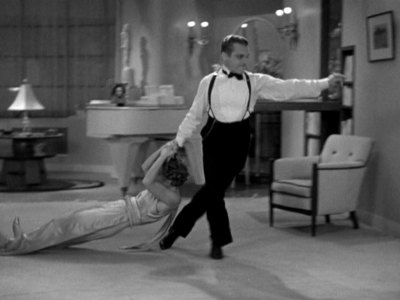
The DVD:
The Video:
The full screen, 1.33:1 black and white video transfer for Lady Killer looks better than I've ever seen it, with a crisp, clean print, perfectly balanced in its gray scale, and light grain.
The Audio:
The Dolby Digital English mono audio track accurately recreates the original theatrical presentation. English and French subtitles are available, as well.
The Extras:
All of the titles in the Warner Bros. Pictures Gangsters Collection: Vol. 3 have a full-length commentary track - a nice option for these lesser known "library titles." Here, film historian Dr. Drew Casper discusses Lady Killer, and although I question some of the deeper meanings he reads into this film (despite the general feeling among many film historians that early film audiences were naive rubes, I believe they were far more sophisticated than they were given credit for - and that they were well aware of this film's aims at spoof and parody. They weren't "conned," like Dr. Casper suggests), he's a thorough, enthusiastic host, with some fun, clever readings of the montages and editing schemes (even if some of those readings may not take into account Warners' quest for economy, in addition to the director's and editor's skill).
There's also an option on all of the Warner Bros. Pictures Gangsters Collection: Vol. 3 films to watch the main flick with the Warner Night at the Movies feature, with a "Play All" ability to view some vintage trailers, newsreels, short subjects and a cartoon before the main feature unspools - just as moviegoers experienced these films back in the 1930s. It's a fun concept (didn't Warner try this on VHS years ago?) that works even better on DVD, because you can also cherry-pick which extras you may want to watch alone. For Lady Killer, there's an original trailer for the film (with the fantastic, substituted scene of Cagney trading "Nuts to you!" over and over again with a drunk moviegoer). There's also a trailer for Cagney's fantastic Footlight Parade, for director Lloyd Bacon. There's a newsreel touting the use of Alcatraz Island for the worst Federal prisoners; it runs 1:32. The Camera Speaks, a Vitaphone "Pepper Pot" from 1934, featuring a story by Billy Bitzer, has a camera speaking to a studio night-watchman, detailing past glories caught by the motion picture camera. It runs 10:30. An operetta short subject, Kissing Time, starring Jane Froman and Georges Metaxa, and directed by Roy Mack, runs 21:49. And finally, there's a Merrie Melodies Hugh Harman, Rudolf Ising, and Leon Schlesinger cartoon, The Shanty Where Santy Claus Lives, which features a modern disclaimer by Warner Bros., warning viewers of its politically incorrect content. It runs 7:11 (note: during the end credits, it is indicated this is a "dubbed version for Turner Networks" - cartoon experts will have to see what has been altered).
BLACK LEGION
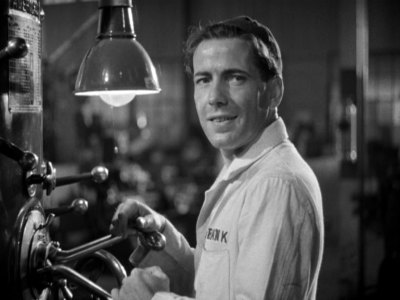
The most problematic inclusion in the Warner Bros. Pictures Gangsters Collection: Vol. 3 - because it's not technically a "gangster" film - this grim, brutal 1937 social action picture takes on the Klan and other American fascist organizations of the 1920s and 1930s, and features a nicely downbeat, proletarian lead performance by that otherwise silky gangster icon, Humphrey Bogart. Bogart plays Frank Taylor, a regular Joe factory worker with a nice wife, Ruth (Erin O'Brien-Moore), a nice kid, Buddy (Dickie Jones), and nice co-worker friend, Ed Jackson (Dick Foran). Sure of his promotion to shop foreman, Frank's safe, measured world slowly begins to unravel when Joe Dombrowski (Henry Brandon), a younger, smarter go-getter at work (who ironically Frank defends when he's ribbed by factory bigot Cliff, played by Joe Sawyer) snags the coveted promotion. Suddenly, Frank's dreams of a new car, a vacuum cleaner, and a new coat for Ruth are dashed, and bitterness takes over.
Finding solace in radio programs that decry the invasion of "foreigners" that take away American jobs from "real" Americans, Frank decides to join, after an entreaty by member Cliff, the Black Legion, a quasi-political group that Frank quickly finds out is nothing more than a gang of ruthless thugs, bent on torturing and harassing anyone who gets in their way. When the increasingly helpless, spiraling Frank sees the power of fascism in action - Dombrowski and his father are run off their poultry farm, which is burned to the ground, and out of town, allowing Frank to finally get his promotion - he wholeheartedly supports the Black Legion. But his increasingly erratic behavior at work (while trying to recruit a new member, he leaves his station during a critical accident) causes stress at home, until he finally loses his job, and his family. When good-guy Ed runs afoul of the Black Legion, tragedy strikes, and Frank reaches the depths of degradation.
SPOILERS ALERT!
It's a stretch to include Black Legion in the Warner Bros. Pictures Gangsters Collection: Vol. 3; I suppose you could say that the fictionalized "Black Legion" included in this film (the story is loosely based on a true incident that happened in Detroit in 1935) operates much like a gang, but again, that's a bit of a reach. As for the film's effectiveness, it's important to note that by this point in Hollywood censorship, the Production Code was being enforced in full. Much of the punch of Black Legion is muted, because specifics have been ameliorated. "Dombrowski," one might assume, is seen as foreign because he's either a Polish or Russian immigrant, or possibly a Jew (Cliff sneeringly makes a reference to his "big nose" always being stuck in a book), but the Code demanded that no specific references to religious intolerance be made, so we have to guess at the exact nature of his "offending nature" to Cliff and Frank and the Black Legion. Same with landlord Mike Grogan (Clifford Soubier), who's identified as Irish, but not as Catholic, which, one might assume from the oath that Bogart reads to join the Black Legion (which includes an anti-Catholic reference), is the reason he is targeted by the Legion.
While modern critics (including one of the commentators on the DVD commentary track) might wish to see a connection with the goings-on in Black Legion and the political climate today in America, that's a big, big stretch, as well. The small fringe group Black Legion of 1937 focuses its sick, racist hatred on legal immigrants who are furthering themselves in America at the expense of no one. These immigrants are the "true" Americans, fulfilling the ideals of the country. Today, the political argument about the illegal invasion of immigrants - a significant number of them with criminal backgrounds - involves hundreds of millions of law-abiding, respectful citizens from all ends of the political spectrum, concerned with criminals who flood into the country unasked (ahead of hopeful immigrants who wait patiently and play by the rules), and who are breaking the back of the social programs that lawful citizens - of all races and backgrounds - increasingly can not afford to support. That's a night and day difference between these two supposedly connected situations. Perhaps what is connected in Black Legion with today's political climate - the voices of hate groups still touting age-old prejudices in the service of gaining political and economic power - is certainly ironic, when one sees that we have a current national political figure unrepentant in his 20-year support of just such a hate group, and yet who apparently doesn't have to be held responsible for that unstinting support, unlike Bogart's Frank Taylor.
Directed by pro Archie Mayo, Black Legion is effective in showing the irony of Frank's life going straight to hell once he embraces a group that supposedly will give him all the social and economic security he apparently craves. The film is quite clever in showing Frank's life as relatively carefree and loving, prior to his disappointment at not getting the initial promotion. His wife is attentive and supportive; his son is a red-blooded, all-American powerhouse who excels at baseball, and who loves to spend time with his father, listening to radio serials. Frank really does "have it all" prior to his own selfish disappointment (and his inherent weakness -- I love the scenes of Frank finding courage when he models his new gun in front of a mirror -- can anybody say Taxi Driver?) in not getting the material gains that go with his promotion. The filmmakers are also quite sly in showing the sublimated violence and unrest in Frank's character, long before he becomes the agent of his friend Ed's destruction (I love Bogart egging on his kid to fight a fellow baseball player, smacking him too hard on the face in a "playful" tap, and even going so far as to gleefully buy the kid a new bat, telling Buddy, "try this out on Muggy!"). The film is cleverly constructed, and features a nicely delineated performance by Bogart (he's great as he tries to read the flowery, ridiculous Black Legion oath of honor), and it works as straightforward melodrama, but as an indictment of fascist groups in America, it may be too blunted by the Production Code to entirely succeed.
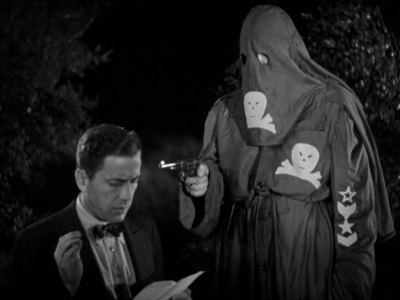
The DVD:
The Video:
The full-screen, 1.33:1 black and white video transfer for Black Legion looks quite, quite good, with a smooth, clear picture, little grain, and no compression issues. Blacks are solid and hold.
The Audio:
The Dolby Digital English mono audio track accurately recreates the original theatrical presentation. English and French subtitles are available, as well.
The Extras:
All of the titles in the Warner Bros. Pictures Gangsters Collection: Vol. 3 have a full-length commentary track - a nice option for these lesser known "library titles." Here, film historians Anthony Slide and Patricia King Hanson discuss Black Legion, thankfully eschewing a detailed, scene-by-scene filleting of the film, opting instead to offer light, well-chosen bios on many of the players, while giving out a lot of good production tidbits on the film. Their chemistry together is quite good (they're both laid back and good-humored about the film), and despite Hanson's serious misstep in comparing the actions in Black Legion to today's concerns about illegal immigrants, they make entertaining hosts for this dark film.
There's also an option on all of the Warner Bros. Pictures Gangsters Collection: Vol. 3 films to watch the main flick with the Warner Night at the Movies feature, with a "Play All" ability to view some vintage trailers, newsreels, short subjects and a cartoon before the main feature unspools - just as moviegoers experienced these films back in the 1930s. It's a fun concept (didn't Warner try this on VHS years ago?) that works even better on DVD, because you can also cherry-pick which extras you may want to watch alone. For Black Legion, there's an original theatrical trailer for the main feature, as well as a trailer for director Michael Curtiz's 1937 comedy, The Perfect Specimen, starring Errol Flynn and Joan Blondell. There's a newsreel highlighting the deep-sixing of captured gangsters' guns; it runs 59 seconds. Hi De Ho, a Vitaphone Melody Master musical short subject starring Cab Calloway and His Orchestra, runs 10:51, and contains a modern warning notice of its "politically incorrect" content. And finally, there's a Merrie Melodies cartoon, produced by Leon Scheslinger, supervised by Ub Iwerks and animated by Chuck Jones and Bob Clampett, called Porky and Gabby, which runs 7:02.
BROTHER ORCHID
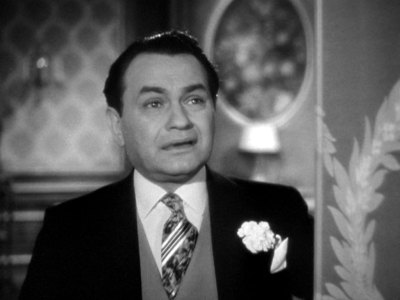
A delightful, gentle (if you can believe that) gangster comedy, and a particular favorite of mine growing up, Brother Orchid shows the full force of the Production Code eviscerating the more violent, anti-social aspects of the gangster genre, but providing an opportunity to twist the genre's expectations, allowing Robinson the chance to stretch his established gangster persona - right before Warners began to let him drift in favor of rising lead Humphrey Bogart, who has a limited supporting role here. Robinson plays Little Johnny Sarto, an established, "corporate" gangster who's dismayed at his associates' rogue operation to rub out one of Little Johnny's rivals. Distressed at his favorite restaurant closing as a result of the hit taking place there, he decides he's going to chase the two qualities he's always desired: good taste and refinement. He retires, and turns over his operation to number two gunsel Jack Buck (Humphrey Bogart). Setting off for Europe, minus his loyal moll Flo Addams (Ann Sothern), Johnny finds out that tough-guy American gangsters in search of "class" are no match for the Old World sharpies who fleece him into bankruptcy with phony antiques, jewelry and spent racing ponies. Forced to hock his fancy threads, Johnny returns home to New York with the intent of taking over his old rackets gang.
But Jack Buck isn't having any of this. He humiliates Johnny (he gives him the hot seat) and throws him out of his old office, forcing Johnny to regroup with Flo (who has done pretty well by herself by hooking up - platonically - with adoring millionaire cowboy Clarence Fletcher, played by Ralph Bellamy), and with loyal gunsel Willie the Knife (Allen Jenkins), in hopes of chipping away at Jack's rackets. A misguided attempt to broker a peace between the two feuding gangsters, engineered by a duped Flo, results in Johnny almost being killed in a forest by two of Jack's gunners. Crawling off, Johnny collapses in front of the Floracian Monastery, where the Little Brothers of the Flowers take him in, no questions asked. There, Johnny learns one of the tenants of true Christianity - helping others with no desire to profit from the interaction - which blows this increasingly repentant gangster's mind. When the opportunity comes for Brother Orchid (Johnny) to help his brethren (their flower market is eliminated because they're not part of Jack's protection racket), while also knocking Jack off his perch, he acts - with life-changing results for the banty gangster.
SPOILERS ALERT!
Brother Orchid appeared much more often on pre-cable TV than the other offerings in the Warner Bros. Pictures Gangsters Collection: Vol. 3 because it was more Code-friendly for nervous TV schedulers, plays like a stealth gangster story. All violence (except for a rowdy fistfight at the climax) is portrayed off screen, with the comedy elements of the film taking far more precedence over the action. The crimes of Johnny's gang seem trivial - protection rackets - compared to the more licentious, sordid crimes of prostitution, drugs and murder that permeated the real gangland crimes of 1940. Even Johnny's hangout - a beautifully appointed boardroom right out of Madison Avenue - seems more "corporate" than "Little Italy," with Johnny's men in nicely cut Brooks Brothers suits, not the flashy, ill-fitting, garish outfits of newly arrived immigrant gangsters. Criminal activity in Brother Orchid is only a means to bookend the comic development of the Sarto character from scheming sharpie to saintly, selfless hero.
There's such a quiet, gentle quality to Brother Orchid, even though it's a fairly rowdy little comedy, that newcomers may well find it a puzzle, when they try to fit it within the pantheon of Warner Bros. gangster films. Always knowing in its comedy (it takes a long time for Johnny to get "the spirit"), Brother Orchid has quite a few laugh-out-loud scenes that may surprise gangster enthusiasts looking for a standard actioner (Robinson acknowledging spiking the milk with water, to gain the record for most productive milking, is beautifully handled). But its gentle quality is most dominate, with a sweet, funny performance by Robinson that illustrates his consummate skill at handling comedy. With an excellent supporting cast (imagine having Ann Sothern, Donald Crisp, Ralph Bellamy, Allen Jenkins, and Cecil Kellaway backing you up), Robinson takes this temperate little fantasy and makes it entirely believable, despite the crimping of the Production Code, as a redemptive tale of true ascension. When Little Johnny gives up Flo to the deserving Clarence, and returns to the Brotherhood of the Little Flowers, open to their selfless love and support, it's a surprisingly moving, emotional moment, more like Capra's It's a Wonderful Life rather than Mervyn LeRoy's Little Caesar - and therefore a most unusual moment in the Warner Bros. gangster timeline.
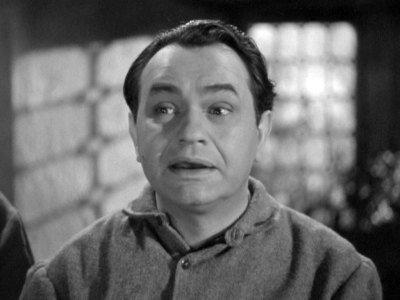
The DVD:
The Video:
The full-screen, 1.33:1 black and white video transfer for Brother Orchid has a beautiful, anomaly-free, creamy-smooth cleanliness - certainly the best one here in the Warner Bros. Pictures Gangsters Collection: Vol. 3. It's super sharp, and there are no compression issues.
The Audio:
The Dolby Digital English mono audio track accurately recreates the original theatrical presentation. English and French subtitles are available, as well.
The Extras:
All of the titles in the Warner Bros. Pictures Gangsters Collection: Vol. 3 have a full-length commentary track - a nice option for these lesser known "library titles." Here, Robinson and Bogart biographers (respectively) Alan L. Gansberg and Eric Lax discuss Brother Orchid, and they're a lot of fun together. Obviously enjoying the film on the level it should be seen at, Lax and Gansberg bring a lot of side information on the stars to light, as well as proving adept surveyors of the post-Code enforcement period at Warners. They're a good team; they should match up again for other titles - regardless of whether Robinson or Bogart are involved.
There's also an option on all of the Warner Bros. Pictures Gangsters Collection: Vol. 3 films to watch the main flick with the Warner Night at the Movies feature, with a "Play All" ability to view some vintage trailers, newsreels, short subjects and a cartoon before the main feature unspools - just as moviegoers experienced these films back in the 1930s. It's a fun concept (didn't Warner try this on VHS years ago?) that works even better on DVD, because you can also cherry-pick which extras you may want to watch alone. For Brother Orchid, there's an original trailer for the main feature, along with an original trailer for director Lewis Seiler's similarly-themed It All Came True, from 1940 and starring Humphrey Bogart. There's a newsreel, with no title, that takes place at Inglewood, California's racetrack, that shows the cream of the Hollywood crop, including Robinson, Norma Shearer (and is that Bugsy Siegel?) enjoying a race. There's no audio for the first part of the newsreel, and then only crowd noises (rather annoying selection - couldn't they have found a different newsreel from this period?). Henry Busse and His Orchestra, a musical short (from 1948?) directed by future big-time 20th Century-Fox director Jean Negulesco, runs 9:47. A color Merrie Melodies cartoon, Busy Bakers, with no production credits, runs 7:04, while black and white Merrie Melodies, Slap Happy Pappy, supervised by Robert Clampett and starring Porky Pig, runs 7:02.
Final Thoughts on the Boxed Set:
The Warner Bros. Pictures Gangsters Collection: Vol. 3 contains a sensation collection of lesser-celebrated Warner Bros. gangster flicks, with some terrific turns by the gangster Holy Trinity: Cagney, Robinson and Bogart. Beautiful transfers and a copious amount of extras for each title make the Warner Bros. Pictures Gangsters Collection: Vol. 3 a must-have for fans of vintage Hollywood features. The Warner Bros. Pictures Gangsters Collection: Vol. 3 gets our highest recommendation here at DVDTalk.com: the DVD Talk Collector Series.
Paul Mavis is an internationally published film and television historian, a member of the Online Film Critics Society, and the author of The Espionage Filmography.


|
| Popular Reviews |
| Sponsored Links |
|
|
| Sponsored Links |
|
|
| Release List | Reviews | Shop | Newsletter | Forum | DVD Giveaways | Blu-Ray | Advertise |
|
Copyright 2024 DVDTalk.com All Rights Reserved. Legal Info, Privacy Policy, Terms of Use,
Manage Preferences,
Your Privacy Choices | |||||||









